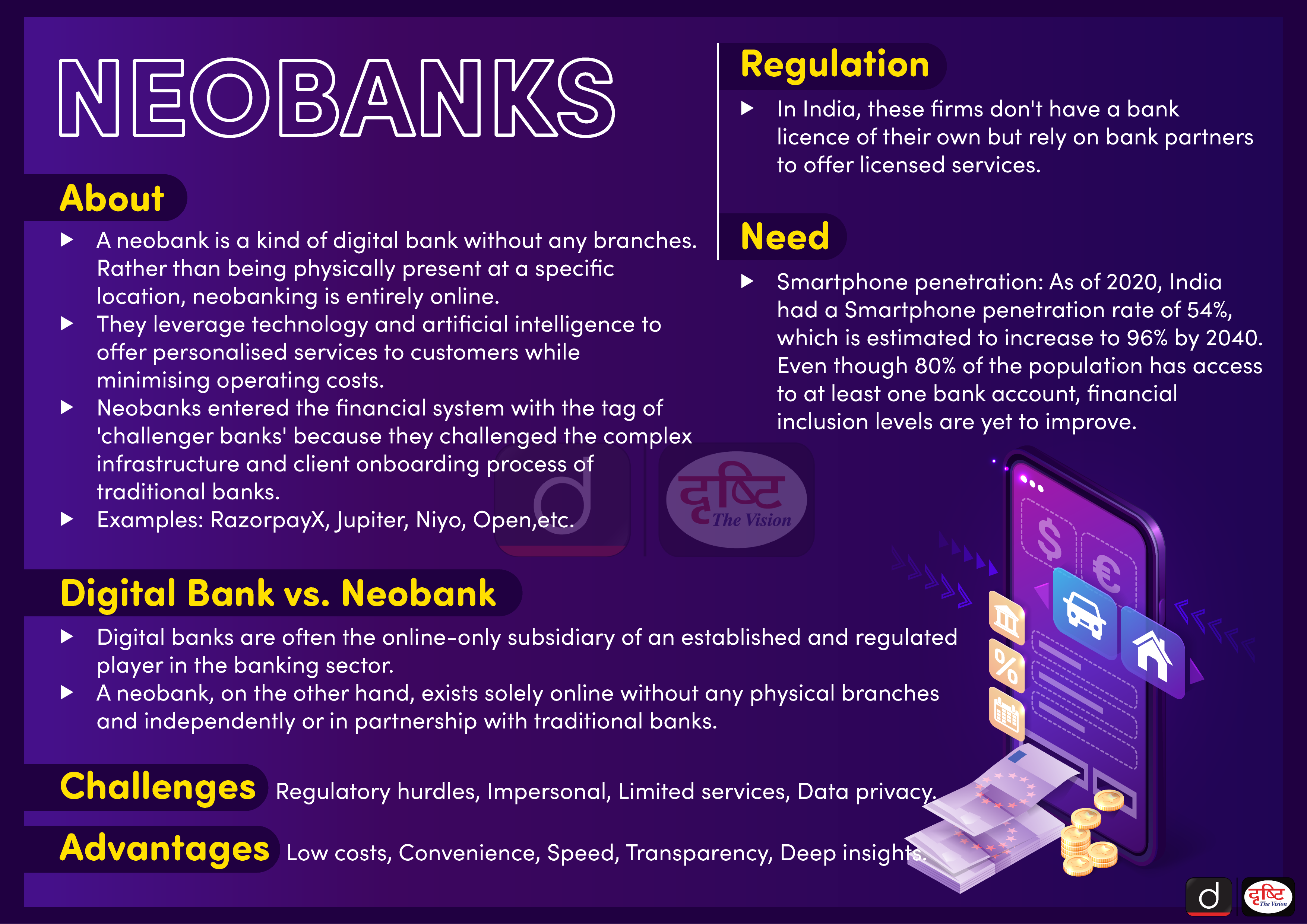Neobanks | 15 Jun 2022
For Prelims: Neobank, Traditional bank, RBI, Digital Banks
For Mains: Role of new online banking system (Neobank) in the inclusive growth and Financial literacy of India, Banking Sector and NBFCs
Why in News?
The RBI (Reserve Bank of India) is taking a hard look at the neobank business model where fintechs plug into a conventional bank’s network and become customer-facing banking service providers.
- The concern is that the digital model business can scale up very fast and could grow to be bigger than the underlying bank in terms of customers. Although neobank customers continue to be accountholders of the underlying bank, the only channel available to these users is the fintech-owned digital platform.
What are Neobanks?
- A neobank is a kind of digital bank without any branches. Rather than being physically present at a specific location, neobanking is entirely online.
- Neobanks are financial institutions that give customers a cheaper alternative to traditional banks.
- They leverage technology and artificial intelligence to offer personalised services to customers while minimising operating costs.
- Neobanks entered the financial system with the tag of 'challenger banks' because they challenged the complex infrastructure and client onboarding process of traditional banks.
- In India, these firms don't have a bank licence of their own but rely on bank partners to offer licensed services.
- That’s because the RBI doesn’t allow banks to be 100% digital yet.
- The RBI remains resolute in prioritising banks’ physical presence, and has spoken about the need for digital banking service providers to have some physical presence as well.
- RazorpayX, Jupiter, Niyo, Open,etc are the examples of top Neobanks of India.
What are the Different Operating Models of Neobanks?
- Non-licensed FinTech (Financial Technology) firms that collaborate with conventional banks to have a mobile/Web platform and a wrapper around their partner banks’ products.
- Traditional banks that are undertaking their digital initiatives.
- Licensed neobanks (usually with digital banking licences in those countries that allow it).
What are the Differences Between Traditional Banks and Neobanks?
- Funding and customers' trust: Traditional banks have many advantages over neobanks, such as funding and most importantly customers' trust.
- However, legacy systems are weighing them down and they find it difficult to adapt to the growing needs of a tech-savvy generation.
- Innovation: While neobanks don’t have the funds or customer base to overthrow traditional banks, they have something special in their arsenal - innovation.
- They can launch features and develop partnerships to serve their customers much more quickly than traditional banks.
- Underserved by traditional banks: Neobanks cater to retail customers, and small and medium businesses, which are generally underserved by traditional banks.
- They leverage the mobile-first model to differentiate themselves by introducing innovative products and providing superior customer service.
- Venture capital and private equity investors: They have been keeping a keen eye on the market opportunities for such banks and are taking an increasing interest in them.
- Smartphone penetration: As of 2020, India had a Smartphone penetration rate of 54%, which is estimated to increase to 96% by 2040.
- Even though 80% of the population has access to at least one bank account, financial inclusion levels are yet to improve.
What are the Challenges for Neobanks?
- Fulfilling the needs of a segment of the market: The key to their success lies in fulfilling the needs of a segment of the market, and adopting the right technology, business strategy and work culture.
- Regulatory hurdles: Since the RBI doesn’t yet recognise neobanks as such, officially customers may not have any legal recourse or a defined process in case of an issue.
- Impersonal: Since neobanks don’t have a physical branch, customers don’t have access to in-person assistance.
- Limited services: Neobanks generally offer fewer services than traditional banks.
What are the Advantages of Neobanks?
- Low costs: Fewer regulations and the absence of credit risk allow neobanks to keep their costs low. Products are typically inexpensive, with no monthly maintenance fees.
- Convenience: These banks offer customers the majority (if not all) of banking services through an app.
- Speed: Neobanks allow customers to set up accounts quickly and process requests speedily. Those that offer loans may skip the usual time-consuming application processes in favour of innovative strategies for evaluating credit.
- Transparency: Neobanks are transparent and strive to provide real-time notifications and explanations of any charges and penalties incurred by the customer.
- Deep insights: Most neobanks provide dashboard solutions with highly enhanced interfaces and easy to understand and valuable insights for services such as payments, payables and receivables, and bank statements.
What is the difference between Digital Banks and Neobanks?
- A digital bank and a neobank aren’t quite the same, even though they appear to be based on the mobile-first approach and emphasis on digital operating models.
- While the terms are sometimes used mutually, digital banks are often the online-only subsidiary of an established and regulated player in the banking sector, a neobank, on the other hand, exists solely online without any physical branches and independently or in partnership with traditional banks.
Way Forward
- Neobanking can work as an extension of measures undertaken to solve the challenges of financial inclusion and bundling banking services with other financial services—for example, services like opening of bank accounts for immigrants, facilitated through new onboarding procedures not based on traditional documentation of identification. With narrow targets initially, neobanks could expand by adding more functionalities and services over time.
- Although digital and neobanks are gathering momentum, most are yet to show sustained profitability. Nevertheless, they have great potential to be disruptors in banking and financial services, and the key towards becoming profitable entities would be to convince traditional banks to invest in new-age technology and re-engineer processes to provide seamless and swift customer experiences.

